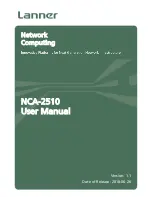
226 Reporting
Scheduling reports
■
Click
Admin
>
Node
>
Manage Report Files
.
2
In
Select Node
, choose a node from the pull-down list, and click
OK
.
3
Do one of the following:
■
In
Report Scheduling
, click
Manage Report Files
.
■
In
Report Files
, proceed to the next step.
4
In
Report Files
, click
Refresh Table
.
Deleting report schedules
The Network Security console provides a way to delete the scheduled, periodic
automatic reports.
To delete scheduled reports
1
In the Network Security console, click
Reports
>
Schedule Reports
.
2
In
Select Node
, choose a node from the pull-down list, and click
OK
.
3
In
Manage Saved Scheduled Reports
, select a scheduled report.
4
Click
Actions
>
Delete
, and click
OK
.
Managing scheduled reports
Symantec Network Security provides an efficient way to manage scheduled
reports using Manage Report Files. Symantec Network Security also provides
the Admin menu as an alternative to managing saved reports via the Reports
menu.
Note:
SuperUsers and Administrators can manage reports; StandardUsers and
RestrictedUsers have read access only. See
“User groups reference”
on page 319
for more about permissions.
This section includes the following topics:
■
Viewing saved reports
■
Exporting saved reports
■
Deleting saved reports
Viewing saved reports
The Network Security console provides a way to view saved reports easily.
Summary of Contents for 10521146 - Network Security 7120
Page 1: ...Symantec Network Security Administration Guide...
Page 12: ...12 Contents Index...
Page 14: ...14...
Page 70: ...70...
Page 110: ...110 Populating the topology database Adding nodes and objects...
Page 158: ...158 Responding Managing flow alert rules...
Page 188: ...188...
Page 242: ...242 Reporting Playing recorded traffic...
Page 268: ...268 Managing log files Exporting data...
Page 316: ...316 Advanced configuration Configuring advanced parameters...
Page 318: ...318...
Page 338: ...338 SQL reference Using MySQL tables...
Page 366: ...366 Glossary...
Page 392: ...392 Index...






































